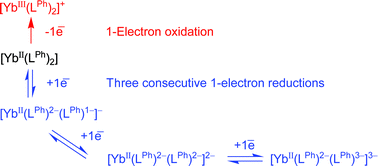Selected homoleptic metal β-diketiminates MIL and MIIL2 [MI = Li or K, MII = Mg, Ca or Yb; L: LPh = {N(SiMe3)C(Ph)}2CH, LBut = N(SiMe3)C(Ph)C(H)C(But)N(SiMe3), L* = {N(C6H3Pri2-2,6)C(Me)}2CH] have been studied by cyclic voltammetry (CV). The primary reduction (Epred, the peak reduction potential measured vs. SCE in thf containing 0.2 M [NBu4][PF6] with a scan rate 100 mV s−1 at a vitreous carbon electrode at ambient temperature) is essentially ligand-centred: Epred being ca.
−2.2 V (LiLPh and KLPh) and −2.4 V [Mg(LPh)2, LiLBut and Ca(LPh)2], while LiL* is significantly more resistant to reduction (Epred = −3.1 V). These observations are consistent with the view that the two (LPh) or single (LBut) C-phenyl substituent(s), respectively, are available for π-electron-delocalisation of the reduced species, whereas the N-aryl substituents of L* are unable to participate in such conjugation for steric reasons. The primary reduction process was reversible on the CV-time scale only for LiLBut, Ca(LPh)2 and Yb(LPh)2. For the latter this occurs at a potential ca. 500 mV positive of Ca(LPh)2, consistent with the notion that the LUMO of Yb(LPh)2 has substantial metal character. The successive reversible steps, each separated by ca. 500 mV, indicate that there is strong electronic communication between the two ligands of Yb(LPh)2. The overall three-electron transfer sequence shows that the final reduction level corresponds to [YbII(LPh)2−(LPh)3−]. DFT calculations on complexes Li(LPh)(OMe2)2 and Li2(LPh)(OMe2)3 showed that both HOMO and LUMO orbitals are only based on the ligand with a HOMO–LUMO gap of 4.21 eV. Similar calculations on a doubly reduced complex Yb{(µ-LPh)Li(OMe2)}2 demonstrated that there is a considerable Yb atomic orbital contribution to the HOMO and LUMO of the complex.

You have access to this article
 Please wait while we load your content...
Something went wrong. Try again?
Please wait while we load your content...
Something went wrong. Try again?


 Please wait while we load your content...
Please wait while we load your content...